sensor PORSCHE 911 TURBO 2014 6.G Owner's Manual
[x] Cancel search | Manufacturer: PORSCHE, Model Year: 2014, Model line: 911 TURBO, Model: PORSCHE 911 TURBO 2014 6.GPages: 300, PDF Size: 10.61 MB
Page 209 of 300
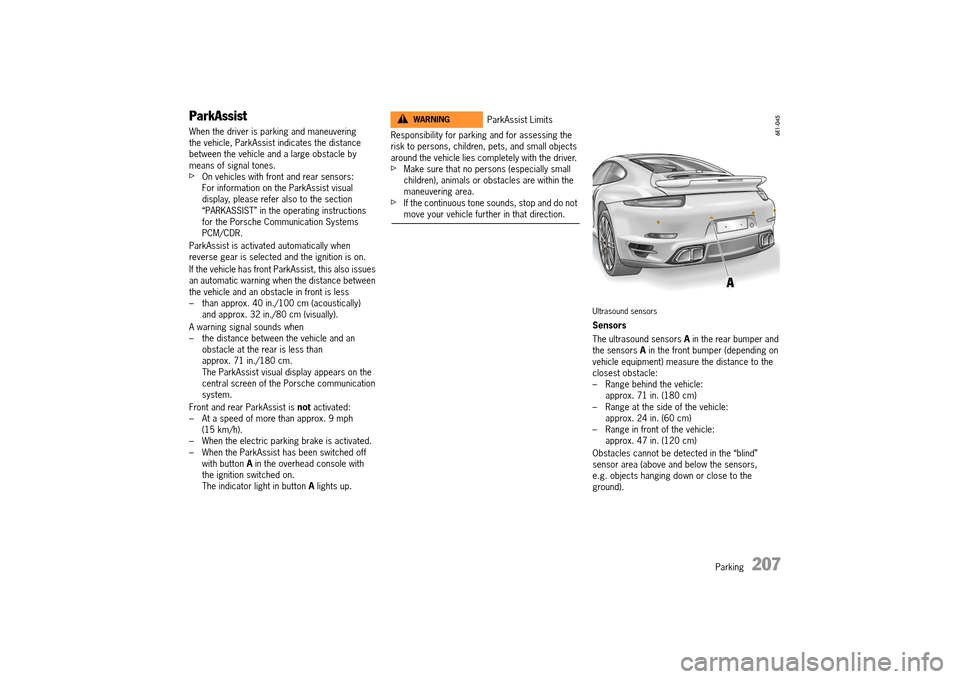
Parking 207
ParkAssist
When the driver is parking and maneuvering the vehicle, ParkAssist indicates the distance between the vehicle and a large obstacle by means of signal tones.fOn vehicles with front and rear sensors:For information on the ParkAssist visual display, please refer also to the section “PARKASSIST” in the operating instructions for the Porsche Communication Systems PCM/CDR.
ParkAssist is activated automatically when reverse gear is selected and the ignition is on.
If the vehicle has front ParkAssist, this also issues an automatic warning when the distance between the vehicle and an obstacle in front is less – than approx. 40 in./100 cm (acoustically) and approx. 32 in./80 cm (visually).
A warning signal sounds when – the distance between the vehicle and an obstacle at the rear is less than approx. 71 in./180 cm.The ParkAssist visual display appears on the central screen of the Porsche communication system.
Front and rear ParkAssist is not activated: – At a speed of more than approx. 9 mph (15 km/h).– When the electric parking brake is activated.– When the ParkAssist has been switched off with button A in the overhead console with the ignition switched on. The indicator light in button A lights up.
Responsibility for parking and for assessing the risk to persons, children, pets, and small objects around the vehicle lies completely with the driver. fMake sure that no persons (especially small children), animals or obstacles are within the maneuvering area. fIf the continuous tone sounds, stop and do not move your vehicle further in that direction.
Ultrasound sensors
Sensors
The ultrasound sensors A in the rear bumper and the sensors A in the front bumper (depending on vehicle equipment) measure the distance to the closest obstacle:– Range behind the vehicle: approx. 71 in. (180 cm)– Range at the side of the vehicle: approx. 24 in. (60 cm)– Range in front of the vehicle: approx. 47 in. (120 cm)
Obstacles cannot be detected in the “blind” sensor area (above and below the sensors, e.g. objects hanging down or close to the ground).
ParkAssist LimitsWARNINGh
14_991_Turbo_21.book Seite 207 Mittwoch, 9. April 2014 2:19 14
Page 210 of 300
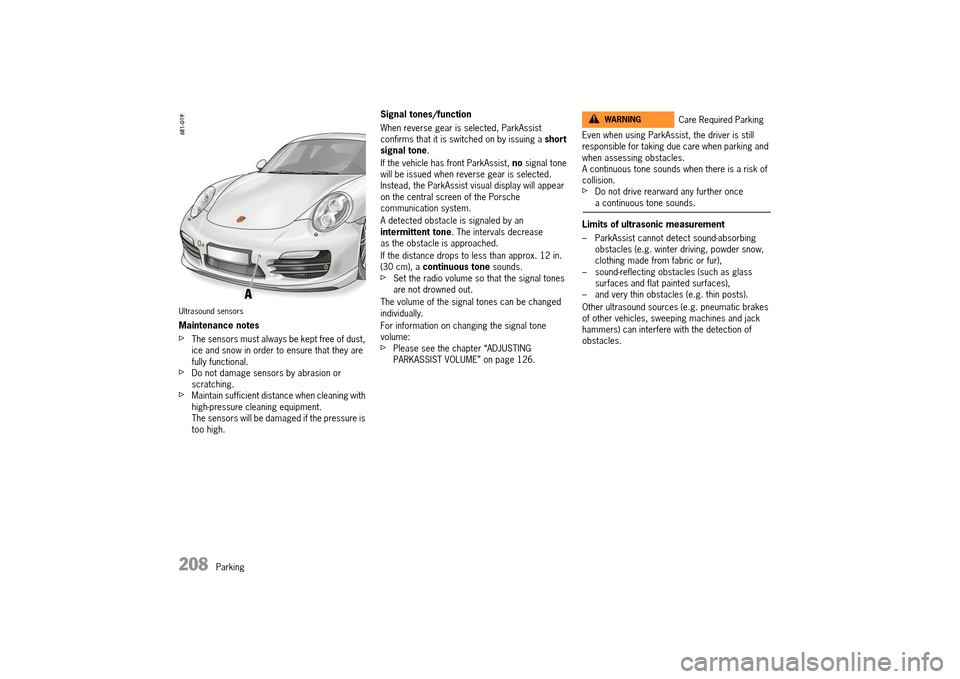
208 Parking
Ultrasound sensors
Maintenance notes
fThe sensors must always be kept free of dust, ice and snow in order to ensure that they are fully functional.fDo not damage sensors by abrasion or scratching.fMaintain sufficient distance when cleaning with high-pressure cleaning equipment.The sensors will be damaged if the pressure is too high.
Signal tones/function
When reverse gear is selected, ParkAssist confirms that it is switched on by issuing a short signal tone .
If the vehicle has front ParkAssist, no signal tone will be issued when reverse gear is selected.Instead, the ParkAssist visual display will appear on the central screen of the Porsche communication system.
A detected obstacle is signaled by an intermittent tone . The intervals decrease as the obstacle is approached.
If the distance drops to less than approx. 12 in. (30 cm), a continuous tone sounds.fSet the radio volume so that the signal tones are not drowned out.
The volume of the signal tones can be changed individually.
For information on changing the signal tone volume:fPlease see the chapter “ADJUSTING PARKASSIST VOLUME” on page 126.
Even when using ParkAssist, the driver is still responsible for taking due care when parking and when assessing obstacles.A continuous tone sounds when there is a risk of collision.fDo not drive rearward any further once a continuous tone sounds.
Limits of ultrasonic measurement
– ParkAssist cannot detect sound-absorbing obstacles (e.g. winter driving, powder snow, clothing made from fabric or fur),– sound-reflecting obstacles (such as glass surfaces and flat painted surfaces),– and very thin obstacles (e.g. thin posts).
Other ultrasound sources (e.g. pneumatic brakes of other vehicles, sweeping machines and jack hammers) can interfere with the detection of obstacles.
Care Required ParkingWARNINGh
14_991_Turbo_21.book Seite 208 Mittwoch, 9. April 2014 2:19 14
Page 211 of 300
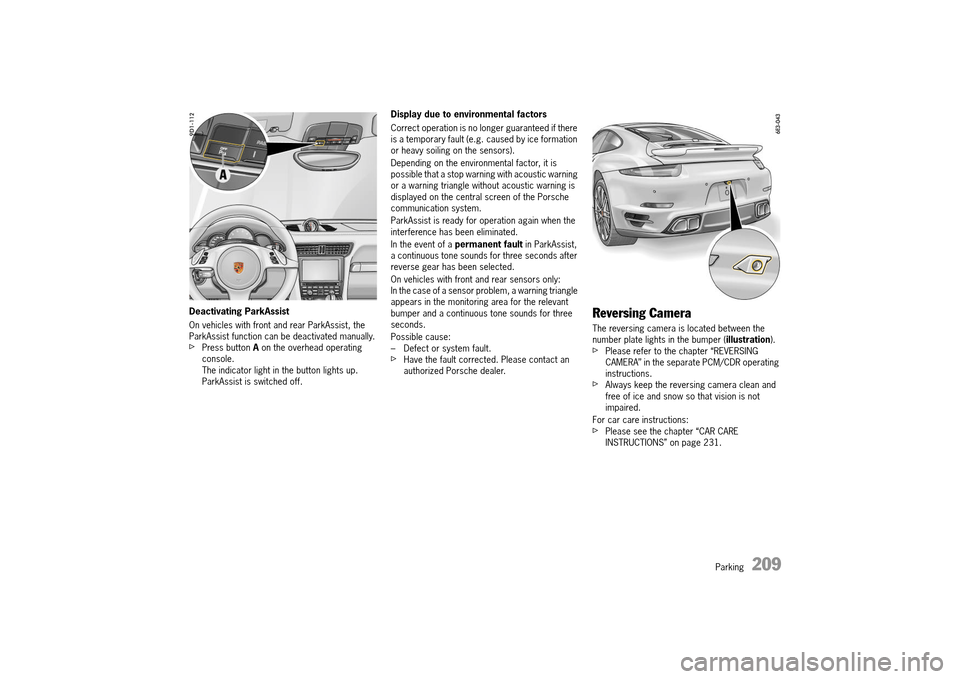
Parking 209
Deactivating ParkAssist
On vehicles with front and rear ParkAssist, the ParkAssist function can be deactivated manually.fPress button A on the overhead operating console.The indicator light in the button lights up.ParkAssist is switched off.
Display due to environmental factors
Correct operation is no longer guaranteed if there is a temporary fault (e.g. caused by ice formation or heavy soiling on the sensors).
Depending on the environmental factor, it is possible that a stop warning with acoustic warning or a warning triangle without acoustic warning is displayed on the central screen of the Porsche communication system.
ParkAssist is ready for operation again when the interference has been eliminated.
In the event of a permanent fault in ParkAssist, a continuous tone sounds for three seconds after reverse gear has been selected.
On vehicles with front and rear sensors only: In the case of a sensor problem, a warning triangle appears in the monitoring area for the relevant bumper and a continuous tone sounds for three seconds.
Possible cause: – Defect or system fault.fHave the fault corrected. Please contact an authorized Porsche dealer.
Reversing Camera
The reversing camera is located between the number plate lights in the bumper ( illustration).fPlease refer to the chapter “REVERSING CAMERA” in the separate PCM/CDR operating instructions.fAlways keep the reversing camera clean and free of ice and snow so that vision is not impaired.
For car care instructions:fPlease see the chapter “CAR CARE INSTRUCTIONS” on page 231.
14_991_Turbo_21.book Seite 209 Mittwoch, 9. April 2014 2:19 14
Page 218 of 300

216 Alarm System and Theft Protection
Alarm System and Passenger
Compartment Monitoring
FCC Numbers :
This device complies with Part 15 of the FCC Rules and RSS-210 of Industry Canada.
Operation of this device is subject to the following two conditions:1. This device may not cause harmful interference, and 2. this device must accept any interference received including interference that may cause undesired operation.
Changes or modifications not expressly approved by the party responsible for compliance could void the user's authority to operate the equipment.
Information
The manufacturer is not responsible for any radio or TV interference caused by unauthorized modifications to this equipment. Such modification could void the user's authority to operate the equipment.
The alarm system monitors the following alarm contacts:– Alarm contacts in doors, luggage compartment lid, engine compartment lid and headlights.– Interior surveillance: Movement in the interior when the vehicle is locked, e.g. attempted theft after breaking a window.– Inclination sensor country-specific equipment: inclination of the vehicle (e.g. when attempting to tow).
If one of these alarm contacts is interrupted, the alarm horn sounds for approx. 30 seconds and the emergency flasher flashes.After 5 seconds of interruption, the alarm is triggered again. This cycle is repeated up to ten times.
Switching on
fThe alarm system is activated when the vehicle is locked.
Switching off
fThe alarm system is deactivated when the vehicle is unlocked.
Information
fIf you unlock the vehicle with the emergency key in the door lock, you must switch the ignition on (ignition lock position 1) within 10 seconds of opening the door in order to prevent the alarm system from being triggered.
Information
If button on the car key is pressed and a door or the luggage compartment lid is not opened, the vehicle is locked again automatically after 30 seconds.
Switching off the alarm system if it is triggered
fUnlock vehicle or switch on ignition.
Switching off interior surveillance and inclination sensor
If people or animals are remaining in the locked vehicle or the vehicle is being transported on, e.g. a train or ship, the interior surveillance system and inclination sensor must be switched off temporarily.fInform any persons remaining in the vehicle that the alarm system will be triggered if the door is opened.
Using the car key
fQuickly press button on the car key twice within 2 seconds.The emergency flasher flashes slowly once.The doors are locked, but can be opened from inside.
USA: KR55WK50138
Canada: 7812D-5WK50138
14_991_Turbo_21.book Seite 216 Mittwoch, 9. April 2014 2:19 14
Page 219 of 300
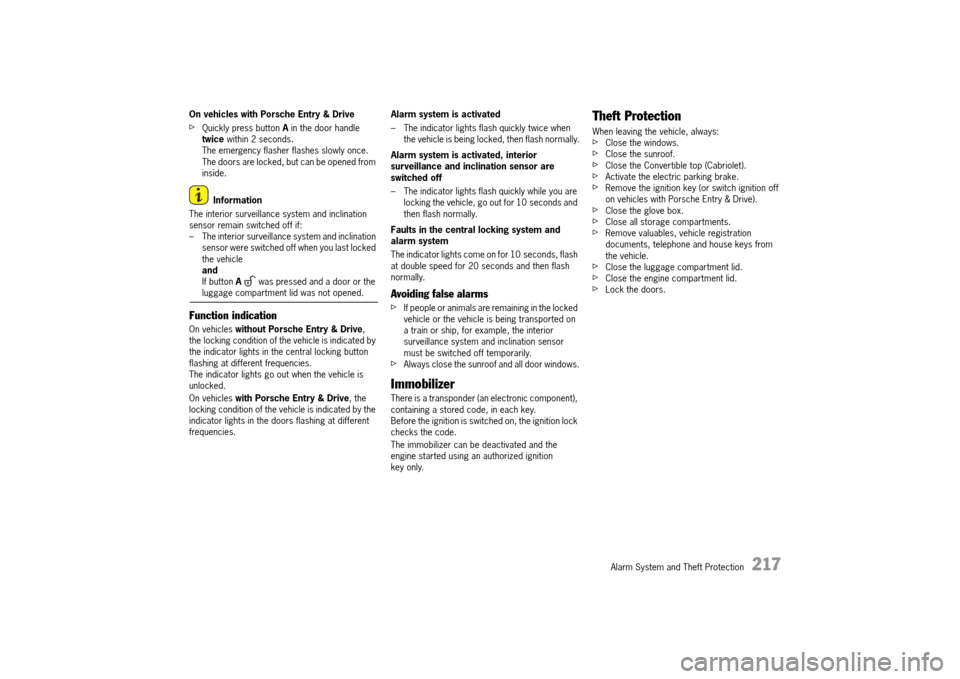
Alarm System and Theft Protection 217
On vehicles with Porsche Entry & Drive
fQuickly press button A in the door handle twice within 2 seconds. The emergency flasher flashes slowly once.The doors are locked, but can be opened from inside.
Information
The interior surveillance system and inclination sensor remain switched off if:– The interior surveillance system and inclination sensor were switched off when you last locked the vehicleandIf button A was pressed and a door or the luggage compartment lid was not opened.
Function indication
On vehicles without Porsche Entry & Drive, the locking condition of the vehicle is indicated by the indicator lights in the central locking button flashing at different frequencies.The indicator lights go out when the vehicle is unlocked.
On vehicles with Porsche Entry & Drive, the locking condition of the vehicle is indicated by the indicator lights in the doors flashing at different frequencies.
Alarm system is activated
– The indicator lights flash quickly twice when the vehicle is being locked, then flash normally.
Alarm system is activated, interior surveillance and inclination sensor are switched off
– The indicator lights flash quickly while you are locking the vehicle, go out for 10 seconds and then flash normally.
Faults in the central locking system and alarm system
The indicator lights come on for 10 seconds, flash at double speed for 20 seconds and then flash normally.
Avoiding false alarms
fIf people or animals are remaining in the locked vehicle or the vehicle is being transported on a train or ship, for example, the interior surveillance system and inclination sensor must be switched off temporarily.fAlways close the sunroof and all door windows.
Immobilizer
There is a transponder (an electronic component), containing a stored code, in each key. Before the ignition is switched on, the ignition lock checks the code.
The immobilizer can be deactivated and the engine started using an authorized ignition key only.
Theft Protection
When leaving the vehicle, always:fClose the windows.fClose the sunroof.fClose the Convertible top (Cabriolet).fActivate the electric parking brake.fRemove the ignition key (or switch ignition off on vehicles with Porsche Entry & Drive).fClose the glove box.fClose all storage compartments.fRemove valuables, vehicle registration documents, telephone and house keys from the vehicle.fClose the luggage compartment lid.fClose the engine compartment lid.fLock the doors.
14_991_Turbo_21.book Seite 217 Mittwoch, 9. April 2014 2:19 14
Page 228 of 300
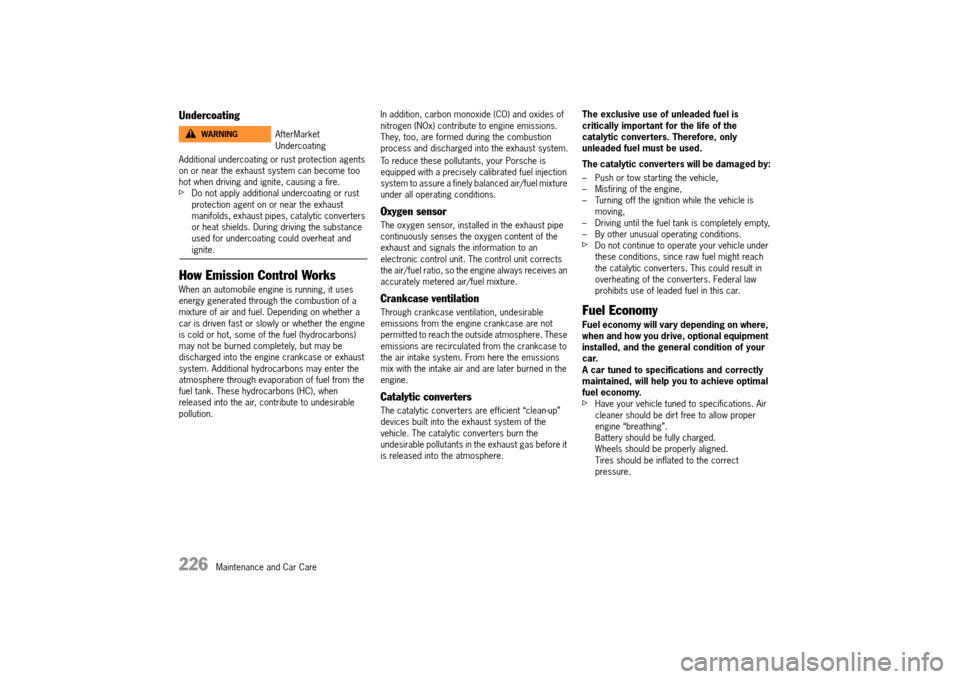
226 Maintenance and Car Care
Undercoating
Additional undercoating or rust protection agents on or near the exhaust system can become too hot when driving and ignite, causing a fire.fDo not apply additional undercoating or rust protection agent on or near the exhaust manifolds, exhaust pipes, catalytic converters or heat shields. During driving the substance used for undercoating could overheat and ignite.
How Emission Control Works
When an automobile engine is running, it uses energy generated through the combustion of a mixture of air and fuel. Depending on whether a car is driven fast or slowly or whether the engine is cold or hot, some of the fuel (hydrocarbons) may not be burned completely, but may be discharged into the engine crankcase or exhaust system. Additional hydrocarbons may enter the atmosphere through evaporation of fuel from the fuel tank. These hydrocarbons (HC), when released into the air, contribute to undesirable pollution.
In addition, carbon monoxide (CO) and oxides of nitrogen (NOx) contribute to engine emissions. They, too, are formed during the combustion process and discharged into the exhaust system.
To reduce these pollutants, your Porsche is equipped with a precisely calibrated fuel injection system to assure a finely balanced air/fuel mixture under all operating conditions.
Oxygen sensor
The oxygen sensor, installed in the exhaust pipe continuously senses the oxygen content of the exhaust and signals the information to an electronic control unit. The control unit corrects the air/fuel ratio, so the engine always receives an accurately metered air/fuel mixture.
Crankcase ventilation
Through crankcase ventilation, undesirable emissions from the engine crankcase are not permitted to reach the outside atmosphere. These emissions are recirculated from the crankcase to the air intake system. From here the emissions mix with the intake air and are later burned in the engine.
Catalytic converters
The catalytic converters are efficient “clean-up” devices built into the exhaust system of the vehicle. The catalytic converters burn the undesirable pollutants in the exhaust gas before it is released into the atmosphere.
The exclusive use of unleaded fuel is critically important for the life of the catalytic converters. Therefore, only unleaded fuel must be used.
The catalytic converters will be damaged by:
– Push or tow starting the vehicle, – Misfiring of the engine,– Turning off the ignition while the vehicle is moving,– Driving until the fuel tank is completely empty,– By other unusual operating conditions.fDo not continue to operate your vehicle under these conditions, since raw fuel might reach the catalytic converters. This could result in overheating of the converters. Federal law prohibits use of leaded fuel in this car.
Fuel Economy
Fuel economy will vary depending on where, when and how you drive, optional equipment installed, and the general condition of your car. A car tuned to specifications and correctly maintained, will help you to achieve optimal fuel economy.fHave your vehicle tuned to specifications. Air cleaner should be dirt free to allow proper engine “breathing”.Battery should be fully charged.Wheels should be properly aligned.Tires should be inflated to the correct pressure.
AfterMarket Undercoating
WARNINGh
14_991_Turbo_21.book Seite 226 Mittwoch, 9. April 2014 2:19 14
Page 234 of 300
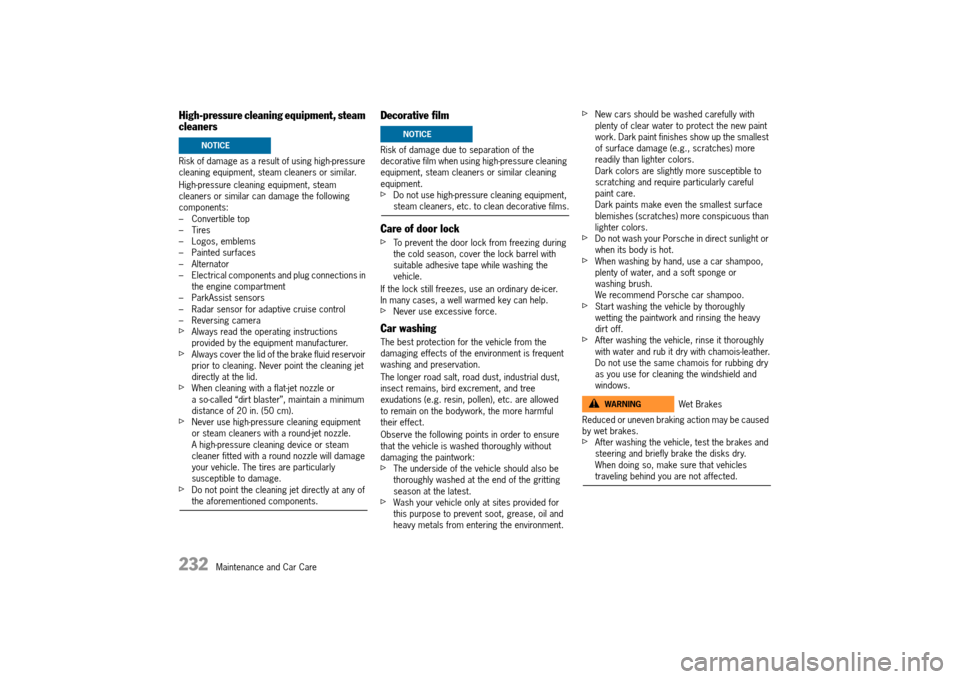
232 Maintenance and Car Care
High-pressure cleaning equipment, steam cleaners
Risk of damage as a result of using high-pressure cleaning equipment, steam cleaners or similar.
High-pressure cleaning equipment, steam cleaners or similar can damage the following components:– Convertible top– Tires– Logos, emblems– Painted surfaces– Alternator– Electrical components and plug connections in the engine compartment– ParkAssist sensors– Radar sensor for adaptive cruise control– Reversing camerafAlways read the operating instructions provided by the equipment manufacturer.fAlways cover the lid of the brake fluid reservoir prior to cleaning. Never point the cleaning jet directly at the lid.fWhen cleaning with a flat-jet nozzle or a so-called “dirt blaster”, maintain a minimum distance of 20 in. (50 cm).fNever use high-pressure cleaning equipment or steam cleaners with a round-jet nozzle.A high-pressure cleaning device or steam cleaner fitted with a round nozzle will damage your vehicle. The tires are particularly susceptible to damage.fDo not point the cleaning jet directly at any of the aforementioned components.
Decorative film
Risk of damage due to separation of the decorative film when using high-pressure cleaning equipment, steam cleaners or similar cleaning equipment.fDo not use high-pressure cleaning equipment, steam cleaners, etc. to clean decorative films.
Care of door lock
fTo prevent the door lock from freezing during the cold season, cover the lock barrel with suitable adhesive tape while washing the vehicle.
If the lock still freezes, use an ordinary de-icer. In many cases, a well warmed key can help.fNever use excessive force.
Car washing
The best protection for the vehicle from the damaging effects of the environment is frequent washing and preservation.
The longer road salt, road dust, industrial dust, insect remains, bird excrement, and tree exudations (e.g. resin, pollen), etc. are allowed to remain on the bodywork, the more harmful their effect.
Observe the following points in order to ensure that the vehicle is washed thoroughly without damaging the paintwork: fThe underside of the vehicle should also be thoroughly washed at the end of the gritting season at the latest.fWash your vehicle only at sites provided for this purpose to prevent soot, grease, oil and heavy metals from entering the environment.
fNew cars should be washed carefully with plenty of clear water to protect the new paint work. Dark paint finishes show up the smallest of surface damage (e.g., scratches) more readily than lighter colors. Dark colors are slightly more susceptible to scratching and require particularly careful paint care.Dark paints make even the smallest surface blemishes (scratches) more conspicuous than lighter colors.fDo not wash your Porsche in direct sunlight or when its body is hot.fWhen washing by hand, use a car shampoo, plenty of water, and a soft sponge or washing brush.We recommend Porsche car shampoo.fStart washing the vehicle by thoroughly wetting the paintwork and rinsing the heavy dirt off.fAfter washing the vehicle, rinse it thoroughly with water and rub it dry with chamois-leather.Do not use the same chamois for rubbing dry as you use for cleaning the windshield and windows.
Reduced or uneven braking action may be caused by wet brakes.fAfter washing the vehicle, test the brakes and steering and briefly brake the disks dry.When doing so, make sure that vehicles traveling behind you are not affected.
NOTICENOTICE
Wet BrakesWARNINGh
14_991_Turbo_21.book Seite 232 Mittwoch, 9. April 2014 2:19 14
Page 235 of 300

Maintenance and Car Care 233
Cleaning in car washes
Optional add-on parts or parts that project beyond the contours of the vehicle may be damaged by design features of car washes.
The following parts are particularly at risk: – Convertible top (hot wax treatment must not be used, as the wax attacks the convertible top material),– Windshield wipers and rear wiper (always switch them off – wiper stalk in position 0 – to prevent them wiping unintentionally in intermittent or sensor operation).– Exterior mirrors (always fold in).– External antenna (always unscrew).– Roof transport system (always remove completely).– Spoilers.– Wheels (the wider the rim and the lower the tire height, the greater the risk of damage).– High-gloss or silk-gloss wheels (to prevent these from getting scratched, do not clean with the wheel-cleaning brushes of the car wash). fPlease consult the operator before using automatic car washes.fAll parts not reached by a car wash, such as door and lid seams or door sills, must be washed and polished by hand.
Information
Automatic car washes spray water at odd angles and high pressures, which are not seen in normal driving. Therefore, water can sometimes find its way into the passengers compartment during or shortly after the car wash.
Convertible top
The service life and appearance of the convertible top depend largely on expert care and operation.
Incorrect care and operation can damage the convertible top or cause it to leak.
Never remove snow and ice with sharp-edged objects.
Cleaning the convertible top
Risk of damage to the convertible top due to the cleaning jet of the high-pressure cleaning equipment or hot wax treatment. fDo not clean the convertible top with high-pressure cleaning equipment. fDo not use hot wax treatment.
Do not wash the convertible top every time you wash the vehicle.
Normally, rinsing the convertible top with clean water is sufficient.fBrush dust off the convertible top in the direction of the weave using a soft brush. fOnly in the case of heavy soiling, wet the convertible top with lukewarm water and a wash-shampoo & convertible-top cleaner and rub gently using a sponge or soft brush.Rinse off wash-shampoo & convertible-top cleaner thoroughly from the convertible top with clean water.We recommend Porsche wash-shampoo.fAfter washing, treat the convertible top at least once a year with a convertible-top care product.Do not allow the convertible-top care product to come into contact with paint or glass. If it does, remove immediately.
fIn the case of leakage in the convertible-top covering or at its seams and folds, use a convertible-top care product.fPlease observe the information on the containers.We recommend Porsche convertible-top care product.fRemove bird excrement immediately. The acid this contains makes the rubber swell and the convertible top will leak.fOpen the convertible top only when completely dry, otherwise damp stains and abrasion marks may occur which cannot be removed.fAttempt to remove spots from the convertible-top covering by rubbing carefully with a soft rubber sponge.
NOTICE
14_991_Turbo_21.book Seite 233 Mittwoch, 9. April 2014 2:19 14
Page 237 of 300
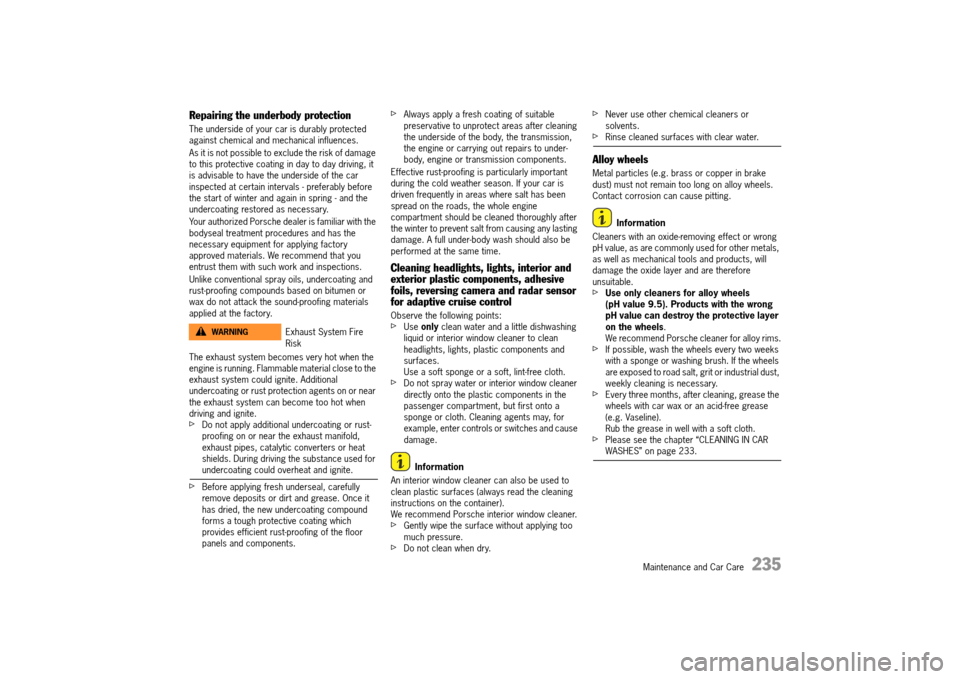
Maintenance and Car Care 235
Repairing the underbody protection
The underside of your car is durably protected against chemical and mechanical influences.
As it is not possible to exclude the risk of damage to this protective coating in day to day driving, it is advisable to have the underside of the car inspected at certain intervals - preferably before the start of winter and again in spring - and the undercoating restored as necessary.
Your authorized Porsche dealer is familiar with the bodyseal treatment procedures and has the necessary equipment for applying factory approved materials. We recommend that you entrust them with such work and inspections.
Unlike conventional spray oils, undercoating and rust-proofing compounds based on bitumen or wax do not attack the sound-proofing materials applied at the factory.
The exhaust system becomes very hot when the engine is running. Flammable material close to the exhaust system could ignite. Additional undercoating or rust protection agents on or near the exhaust system can become too hot when driving and ignite.fDo not apply additional undercoating or rust-proofing on or near the exhaust manifold, exhaust pipes, catalytic converters or heat shields. During driving the substance used for undercoating could overheat and ignite.
fBefore applying fresh underseal, carefully remove deposits or dirt and grease. Once it has dried, the new undercoating compound forms a tough protective coating which provides efficient rust-proofing of the floor panels and components.
fAlways apply a fresh coating of suitable preservative to unprotect areas after cleaning the underside of the body, the transmission, the engine or carrying out repairs to under-body, engine or transmission components.
Effective rust-proofing is particularly important during the cold weather season. If your car is driven frequently in areas where salt has been spread on the roads, the whole engine compartment should be cleaned thoroughly after the winter to prevent salt from causing any lasting damage. A full under-body wash should also be performed at the same time.
Cleaning headlights, lights, interior and exterior plastic components, adhesive foils, reversing camera and radar sensor for adaptive cruise control
Observe the following points: fUse only clean water and a little dishwashing liquid or interior window cleaner to clean headlights, lights, plastic components and surfaces.Use a soft sponge or a soft, lint-free cloth.fDo not spray water or interior window cleaner directly onto the plastic components in the passenger compartment, but first onto a sponge or cloth. Cleaning agents may, for example, enter controls or switches and cause damage.
Information
An interior window cleaner can also be used to clean plastic surfaces (always read the cleaning instructions on the container).We recommend Porsche interior window cleaner.fGently wipe the surface without applying too much pressure.fDo not clean when dry.
fNever use other chemical cleaners or solvents.fRinse cleaned surfaces with clear water.
Alloy wheels
Metal particles (e.g. brass or copper in brake dust) must not remain too long on alloy wheels.Contact corrosion can cause pitting.
Information
Cleaners with an oxide-removing effect or wrong pH value, as are commonly used for other metals, as well as mechanical tools and products, will damage the oxide layer and are therefore unsuitable.fUse only cleaners for alloy wheels (pH value 9.5). Products with the wrong pH value can destroy the protective layer on the wheels . We recommend Porsche cleaner for alloy rims.fIf possible, wash the wheels every two weeks with a sponge or washing brush. If the wheels are exposed to road salt, grit or industrial dust, weekly cleaning is necessary.fEvery three months, after cleaning, grease the wheels with car wax or an acid-free grease (e.g. Vaseline).Rub the grease in well with a soft cloth.fPlease see the chapter “CLEANING IN CAR WASHES” on page 233.
Exhaust System Fire Risk
WARNINGh
14_991_Turbo_21.book Seite 235 Mittwoch, 9. April 2014 2:19 14
Page 252 of 300

250 Minor Repairs
Wheel alignment, wheel balancing
As a precaution, have wheels with summer tires balanced in the spring, and those with mud and snow tires before winter. Unbalanced wheels may affect car handling and tire life.Only the specified weights may be used for wheel balancing.
Self-adhesive weights must not come into contact with cleaning agents, since they could drop off.Uneven tread wear indicates wheel imbalance. In this event, the vehicle should be checked at an authorized Porsche dealer.
If, during a trip, uneven running or vibrations occur that could be caused by damage to tires or the car, the speed must be reduced immediately, but without braking sharply. If you continue your trip without having the cause of the fault remedied, you might lose control of your vehicle.fStop the vehicle and check the tires.fIf no cause for the fault can be found, drive carefully to the nearest authorized Porsche dealer.
The summer tires of your Sports Car have been specially developed and adapted for high performance. At low outside temperatures (<15°C (60°F)), the tire characteristics change. This can result in noises occurring when parking or maneuvering at low outside temperatures.
Wheels with Tire Pressure Monitoring System (TPMS) sensors
Before changing wheels, make sure that the wheels are compatible with your vehicle’s TPMS.fCheck this with your authorized Porsche dealer.
Removing and storing tires
fAfter changing, adjust tire pressure and torque wheel bolts diagonally. Please see the chapter “CHANGING WHEELS” on page 254.fStore tires in a cool and dry place. Rotate periodically to avoid flat spots.fDo not store summer tires or park vehicles fitted with summer tires at ambient temperatures below 5 °F (-15 °C).fAvoid contact with fuel, oil and grease.
Tires must always remain on the same side of the vehicle.When wheels are removed, the direction of rotation and position of each wheel should be marked.
Example
FR (front right), FL, RR and RL.
Wheels must always be fitted in accordance with their marking.
The perception that tire durability and performance are not affected by storage and age is unfounded. Chemical additives, which make the rubber elastic, lose their effectiveness over the course of time and the rubber becomes brittle and cracks.
Therefore, the tires should be inspected from time to time.
Information
Under no circumstances should tires older than 6 years be used on your Porsche.
The age of the tire can be obtained from the “DOT” code number. If, for example, the last four numbers read 1213, then the tire was produced in the 12th week of 2013.
Snow tires
The installation of Porsche approved snow tires is recommended.
Use Porsche approved snow tires for grip on snow and ice. Summer performance tires are not suitable for usage in cold, snowy, or icy conditions.Check with your local Motor Vehicle Bureau for possible restrictions.
High-Speed tire Vibration
DANGERh
14_991_Turbo_21.book Seite 250 Mittwoch, 9. April 2014 2:19 14